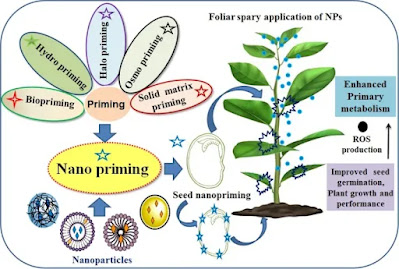Journal of Nanobiotechnology 20, 254 (2022)
Nano-priming is an innovative seed priming technology that helps to improve seed germination, seed growth, and yield by providing resistance to various stresses in plants. Nano-priming is a considerably more effective method compared to all other seed priming methods. The salient features of nanoparticles (NPs) in seed priming are to develop electron exchange and enhanced surface reaction capabilities associated with various components of plant cells and tissues. Nano-priming induces the formation of nanopores in shoot and helps in the uptake of water absorption, activates reactive oxygen species (ROS)/antioxidant mechanisms in seeds, and forms hydroxyl radicals to loosen the walls of the cells and acts as an inducer for rapid hydrolysis of starch. It also induces the expression of aquaporin genes that are involved in the intake of water and also mediates H2O2, or ROS, dispersed over biological membranes. Nano-priming induces starch degradation via the stimulation of amylase, which results in the stimulation of seed germination. Nano-priming induces a mild ROS that acts as a primary signaling cue for various signaling cascade events that participate in secondary metabolite production and stress tolerance. This review provides details on the possible mechanisms by which nano-priming induces breaking seed dormancy, promotion of seed germination, and their impact on primary and secondary metabolite production. In addition, the use of nano-based fertilizer and pesticides as effective materials in nano-priming and plant growth development were also discussed, considering their recent status and future perspectives.

